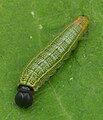Urbanus proteus
| Urbanus proteus | ||||||||||||
|---|---|---|---|---|---|---|---|---|---|---|---|---|

Urbanus proteus |
||||||||||||
| Systematics | ||||||||||||
|
||||||||||||
| Scientific name | ||||||||||||
| Urbanus proteus | ||||||||||||
| ( Linnaeus , 1758) |
Urbanus proteus is a butterfly ( butterfly ) from the family of the thick-headed butterfly (Hesperiidae). It occurs from Florida and Texas across Central America to South America.
features
butterfly
The wingspan of the moth is 45 to 60 millimeters. Front and rear wings have a brown base color on the upper and lower side. They are provided with some whitish spots. The bluish to greenish colored root area on the upper side of the wing is typical of the species. The thorax and abdomen also show this color. The undersides of the wings are brown and have very few small, white spots. The particularly long tails on the tornus of the hind wings are noticeable , which is why the species is sometimes referred to in English as the long-tailed skipper ("Langschwänziger Dickkopffalter").
egg
The eggs are whitish when laid, but soon take on a yellowish color and are usually laid in groups of up to 20 on the underside of the leaves of a food plant. There are many longitudinal ribs on the surface.
Caterpillar
Adult caterpillars are greenish in color and have two yellowish side lines. The entire body is very finely dotted whitish to yellowish. A short orange segment can be seen at the end of the body. The head and neck shield are black-brown and clearly stand out. There is a red spot on each side of the head.
Doll
The pupae are red-brown in color and are coated with a white, waxy powder layer.
Distribution and occurrence
The distribution area of the species extends from Florida and Texas to the south across the Central and South American continent. It is also found in the Antilles and the Bahamas . As a migratory butterfly , it has occasionally been found in more northerly US states, for example in Connecticut and Michigan . Urbanus proteus prefers to colonize open garden and field landscapes.
Way of life
The moths fly in several generations throughout the year. The caterpillars feed on the leaves of various legumes (Fabaceae). They live in nests of rolled up and spun leaves, which is why the species is known in English as a long-tailed skipper and a bean leafroller (freely translated: "bean leaf curler"). At kidney beans ( Phaseolus vulgaris ) they can sometimes harmful are.
Subspecies
In addition to the nominate form Urbanus proteus proteus , the subspecies Urbanus proteus domingo is found on Grenada and Haiti .
supporting documents
Individual evidence
- ↑ Butterflies and Moths of North America http://www.butterfliesandmoths.org/species/Urbanus-proteus
- ↑ Development cycle http://www.buglifecycle.com/?page_id=2576
- ↑ Bean Leafroller http://entnemdept.ufl.edu/creatures/veg/bean/bean_leafroller.htm
- ↑ a b c James A. Scott (1986). The Butterflies of North America: A Natural History and Field Guide. Stanford, California: Stanford University Press. ISBN 0-8047-2013-4 , p. 475
- ↑ Distribution and subspecies http://www.nic.funet.fi/pub/sci/bio/life/insecta/lepidoptera/ditrysia/hesperioidea/hesperiidae/pyrginae/urbanus/index.html#proteus
literature
- James A. Scott (1986). The Butterflies of North America: A Natural History and Field Guide. Stanford, California: Stanford University Press. ISBN 0-8047-2013-4 , p. 475
Web links
- eol.org - Encyclopedia of Life



